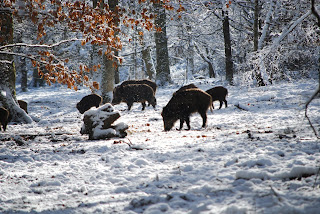Imagine an alien species that escapes the confines and invades the locals, unleashing terror upon them. Sounds like a Hollywood movie, right? However, something similar is actually happening in the US right now.
America is facing the terror of “super-pigs” currently, which came into existence after cross-breeding domestic pigs with wild boars. The species was cross-bred in Canada decades ago. Eventually, it escaped captivity and spread throughout the country. Now it is threatening its way towards Northern America.
What is the “Super Pigs” problem?
In the 1980s, European wild boars were first introduced into Canada to bring an exotic pork product to be served in high-scale restaurants. Later, in order to make the pigs bigger and meatier, they were cross-bred with the local pigs giving rise to the “super pigs”. The Super pigs gained the trait of thick furr making them easily adaptable to the harsh cold conditions of Canada. They can even tunnel their way two meters below the snow to survive the extreme winters.
Image Credits: Pexels
Who would have thought that the pigs bred for the purpose of enhancing pork production would become responsible for wreaking havoc once escaping captivity. As the market for large pigs collapsed around 2001, over 300 pigs were released into nature while others also eventually escaped. Their strength gave them an upper hand at escaping the fencing.
Once out, the Super Pig pig population exploded in Canada. Their strength and ability to adapt to the harsh climate made them a successful invasive species. Super pigs can grow well over 600 pounds and can feed upon almost anything. Not only do they prey on food stocks of native animals, but they also feed on agricultural crops and damage the soil in the process, making it easier for the invasive plant species to grow.
How are “Super Pigs” a threat to the US?
The USA has already been dealing with the feral pigs problem for decades. Pigs were never a native species here. They were introduced here in the 1500s from Europe, and just like the wild boars in Canada, feral pigs in the US escaped their confines and became an invasive species. Every year, the US faces hefty losses of 1.5 billion dollars as a result of crops damaged by these pigs.
However, the feral pigs are mostly restricted to the warmer states of the US, i.e., Texas and Florida in the south. But the super pigs from Canada can very well survive in the cold winters of the northern states of America, adding to the injury caused by pigs in the US.
Image Credits: Pixabay
After causing a disaster in Canada, the Super Pigs are well on their way toward North America. This is why the government is on alert to prevent the super pigs from invading the US. Some feral pigs that seemed to be originated in Canada were reportedly sighted by Wildlife officials in North and South Dakota, but so far none have been able to establish a permanent population here.
What is the action plan against this “Super pigs” problem?
Pigs are incredibly intelligent and difficult to track predators. Other than harming the crops, they attack the nests of native animals like deer, turkeys and quails, and feed on their younglings. They also are vessels that carry viruses dangerous to humans posing a health and safety threat. US researchers along with the government are utilising various methods to curb the pig problem.
All methods ranging from poisoning the wild pigs to catching pigs in big traps have been attempted. Hunting is a common wildlife-management practice in the United States and has been considered to be employed against the pigs problem as well. Many people spend grand money on hog hunting. However, hunting seems to have little effect against the “Super Pigs”.
Super Pigs are very smart. The male pigs are huge in size and have big tusks making them dangerous predators. They have also proved to be excellent breeders. Their capability to produce two litters of six in a year makes it difficult for hunting to keep up. Moreover, they are very elusive. Once they sense the pressure of people hunting them, they can even go completely nocturnal. They spread out and hide in the heavy forest covers and wetlands, making them difficult to be tracked.
Image Credits: Pexels
One method that has worked with the wild pig problem in the US so far is using a “Jonas Pig”. A lone pig is captured to be tagged and then released in nature in hopes that it will join the bigger group of pigs in the wild. Once it joins the unsuspecting pig group, the group is hunted down and the collared animal is let go again and it continues to find more and more pigs.
According to Ryan Brooke, the man behind the University of Saskatchewan’s Canadian wild pig research project, Wild Pigs are the most invasive large mammals on the planet. But Super Pigs are much worse. “You simply can’t barbeque your way out of the pig problem. This is the reality”, he added. He also mentions that it is required to mix-match a variety of methods in order to handle the “super pigs” problem. Furthermore, he stated that in the United States, efforts are needed to manage the damage caused by these animals rather than focusing on eradicating them completely.
If you enjoyed reading our articles, please consider supporting us by buying our geeky merchandise on Instagram.
Alternatively, you could Buy us a coffee or follow us on Facebook, Twitter, Pinterest or Medium!






